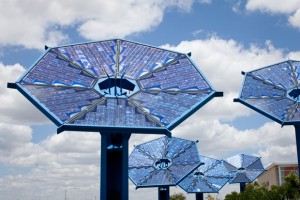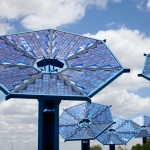Texas Professor Has Bright Ideas for Solar Power

Photo by Mose Buchele/StateImpact Texas
Xiaoyang Zhu of the University of Texas has made a surprising breakthrough in solar power.
By almost any measure, 2011 was a rough year for solar power in the U.S. Federal subsidies to Solyndra became the focus of a congressional investigation after the company went bankrupt. Other solar outfits are feeling pressure on two fronts: low-cost Chinese-manufactured panels are driving prices down around the world, and electricity from America’s newly unleashed natural gas reserves is making power from renewable sources seem less economical.
But at the end of the year, a scientist in Austin has brought a little sun into the forecast. Meet Xiaoyang Zhu, a chemistry professor at the University of Texas, and director of the Energy Frontier Research Center.
For the last few years Zhu and his team have been working on a way to dramatically increase the amount of energy harvested from Solar technology. Now, they think they’ve done it.
“So our recent discovery is this. If you have a light photon,” he says to me, then pauses. “I guess this concept is simple enough, yea?”
Well, maybe not for many of us. Here’s a little background. Solar panels capture energy from light photons. But when the photon is too hot, with energy too high, traditional techniques only capture part of it. Most of the light converts to heat. Zhu’s team has found away to absorb those photons into a plastic. To put them in what scientists call a “dark state.”
“In this dark state, this one electron hole pair becomes two electrons hole pair,” Zhu says. “Of course it’s very difficult to describe in common language. You hear about this thing called quantum weirdness?”
Again, I shake my head no.
It took some explaining – but here’s the upshot: In this “dark state” Zhu was actually able to harvest two electrons of energy from one hot photon.
“So, the conventional Solar panel. That efficiency theoretically is 31 percent. With our discovery the theoretical efficiency increases to 44 percent.”
That’s a more than 40 percent increase in the amount of energy that can be produced from a solar panel. But you can’t do it with traditional silicone photovoltaic cells. Remember, I said Zhu’s team has been using plastic to capture the energy.
“The advantage of course, is obvious when I say plastic,” he says. “It’s cheap.”
Engineering the new plastic semiconductor solar cells to the point that they could be commercially viable is Zhu’s next challenge. “A friend of mine at MIT, a group at MIT is actually trying to do that,” he says. “And the efficiency is not there yet.”
But he’s confident that within a few years, solar cells that can capture more energy than anything we have today will be reality outside the laboratory. And that should do a lot to spark greater interest in solar power.
Correction: An earlier version of this story quoted Dr. Zhu as referring to an “electron whole pair,” the correct term is “electron-hole pair.”




